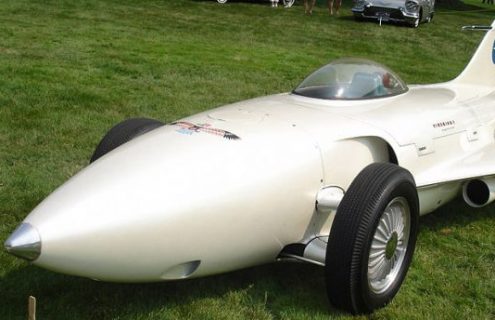Wander around racing chat rooms and you can find more bile being spilled regarding the DeltaWing entry at Le Mans than just about any racing car since Enzo Ferrari ridiculed the mid-engined Coopers in the late 1950s.
When I first saw it, in the infield of qualifying at Indy in 2010, the first thing that ran through my mind was, “GM Firebird”. Its tall vertical stabilizer is a direct echo of the GM concept car. The DeltaWing is certainly radical looking.
And radical and ridiculous aren’t that far away from each in the dictionary. When you view something as visually radical as the DeltaWing, the first thought is, “who would think of something like that?” The who, in the case of the DeltaWing, is Ben Bowlby, no stranger to race car development. He was the Chief Designer at Lola after all – and if you don’t know Lola . . .
So why did someone steeped in current racing car technology come up with a design that one wag described as, “something an 8 year old boy drew in a bored moment during class”? Actually the question should be why hasn’t this been done before.
There IS a good reason for this design. The DeltaWing was designed to fix the failure of current race car aero tech, and that’s the current tech’s inability to provide real ‘racing’, passing in and around the corners – not just ‘passing in the pits’.
Aero grip was a development, along with modern tire technology, of experimentation in racing sports cars in the 1960s. One of the first to explore aero grip was Jim Hall of Chaparral fame. The huge rear wing on the Chaparral 2E (which was a moveable device – operated by a pedal in the cockpit) was the beginning. And there’s a direct line from the Chaparral 2E to the F1 cars in service now.
The problem is that the aero grip generated by the front wings on cars washes out when a car comes up behind another. Without the aero grip, the car understeers like a pig and the trailing car loses ground to the car ahead of it. That’s the problem that Ben Bowlby was trying to solve with the DeltaWing.
The DeltaWing has much less frontal area than other racing cars, and doesn’t rely on the nose for any aero grip. It can come right up behind another car and not get washed out. Which means it can pass. In the process, they’ve put about 70 percent of the weight on the rear of the car, cut the weight to 475 kg (folks, the car weighs approximately 1050 lbs – a silly sack of potatoes more than 1 grand). Couple that radical weight to 300 + hp and you’re close to F1 power/weight ratios.
If there was any one issue that caused sleepless nights, it was probably how to manage the steering. Ben Bowlby said that the initial plan was to race the car as a trike, but racing rule books and trikes aren’t compatible. So they speced two wheels up front. But with over 70 percent of the mass in back and the huge wheelbase, 125 inches, which is longer than the Mercedes Benz W221 S-class long wheel base car, the front wheels are probably more like a rudder than the front wheels on a normal car.
While rear engined top fuel dragsters are now the norm, most people don’t know the story of how Don Garlits solved the problem with steering that allowed rear engined top fuel cars to work – without killing their drivers. I suspect there was some sort of similar breakthrough with the DeltaWing.
So DeltaWing purposed the initial design as a entrant for the 2012 IndyCar chassis competition. And it would have woken up a new generation to open wheel racing. Because if it looks like an 8 year old designed it, you can believe 8 year olds would love it. The Dallara proposal won. And that appeared, to me, to be the death knell of the DeltaWing.
But the company hung in there and now they are running Le Mans as the ’56th’ entry. The 56th entry was created specifically for Le Mans by the ACO, the organizing body of the race, to highlight new technologies. It runs as a demonstration – not eligible for prizes, but as a means of evaluating technology. And it’s the side effects of the DeltaWing, the low weight and small 1.6 liter turbocharged four cylinder engine that the ACO is intrigued by. But you can bet that the folks at DeltaWing are more interested in where it finishes on Sunday.
DeltaWing is supported by All American Racers, Dan Gurney’s operation, Highcroft Racing, Don Panoz, and just this week Nissan was announced as the engine supplier. Nissan is delivering a tuned version of the DIG-T 1.6L four that runs in their popular Juke model. DIG-T istands for direct injected gas – turbocharged. And 300 + HP is not a stretch for that engine.
Believe it or not, word was that BMW was approached about supplying engines for the DeltaWing, but as is now evident, that didn’t happen. Time will tell – another couple of months – whether Nissan and DeltaWing are heroes or goats. But I’m pulling for hero.
So, it’s time for a poll, radical or ridiculous – and as always the comment section is open.
Note: There is a poll embedded within this post, please visit the site to participate in this post's poll.





Author: Hugo Becker
Source: http://www.bmwblog.com/2012/03/16/the-s ... t-le-mans/




